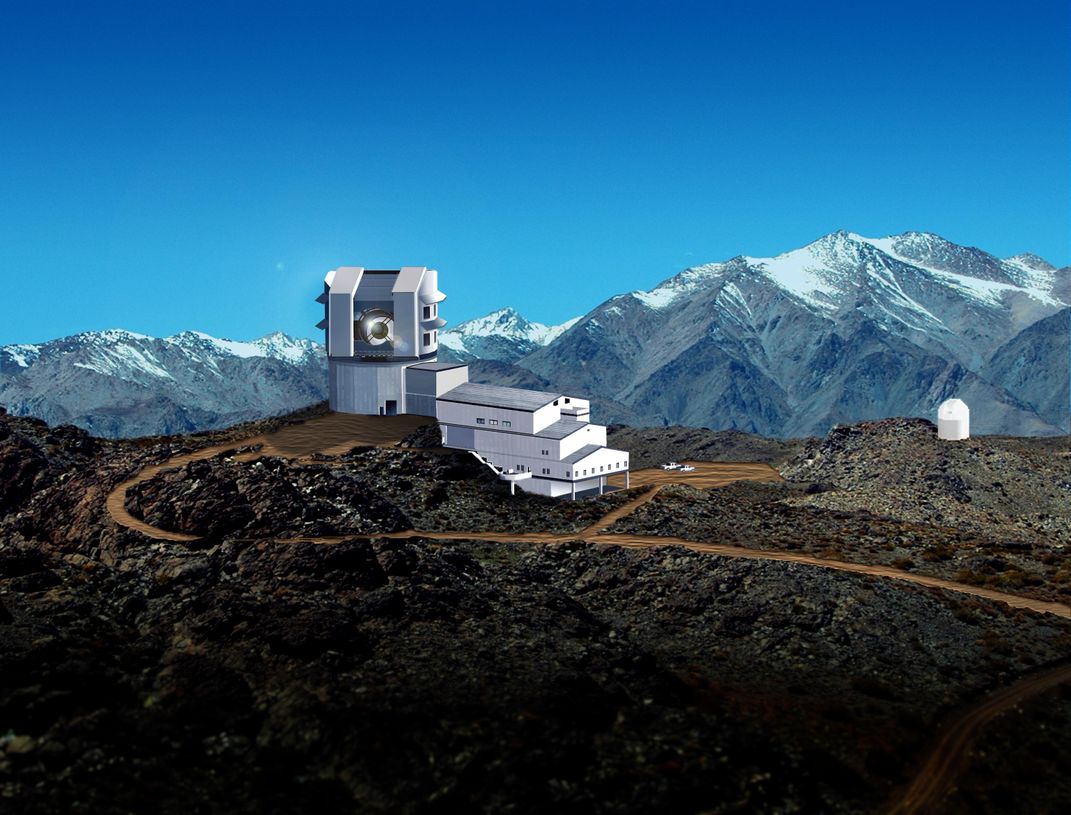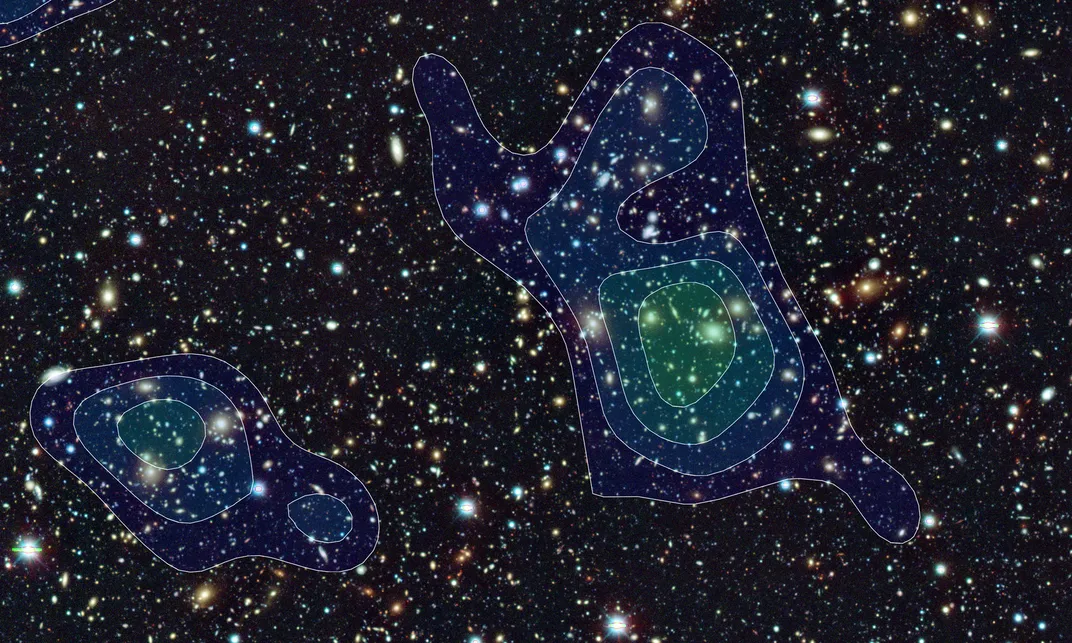“Weak Lensing” Helps Astronomers Map the Mass of the Universe
By making galaxies a little bit brighter, it points the way to elusive galaxies and lets us detect that most mysterious of substances: dark matter
/https://tf-cmsv2-smithsonianmag-media.s3.amazonaws.com/filer/82/98/8298c3f1-7c49-42e1-91b0-6c291f5064e5/bulletcluster_comp_f2048.jpg)
In ordinary visible light, this cluster of galaxies doesn’t look like much. There are bigger clusters with larger and more dramatic-looking galaxies in them. But there’s more to this image than galaxies, even in visible light. The gravity from the cluster magnifies and distorts light passing near it, and mapping that distortion reveals something about a substance ordinarily hidden from us: dark matter.
This collection of galaxies is famously called the “Bullet Cluster,” and the dark matter inside it was detected through a method called “weak gravitational lensing.” By tracking distortions in light as it passes through the cluster, astronomers can create a sort of topographical map of the mass in the cluster, where the “hills” are places of strong gravity and “valleys” are places of weak gravity. The reason dark matter—the mysterious substance that makes up most of the mass in the universe—is so hard to study is because it doesn’t emit or absorb light. But it does have gravity, and thus it shows up in a topographical map of this kind.
The Bullet Cluster is one of the best places to see the effects of dark matter, but it’s only one object. Much of the real power of weak gravitational lensing involves looking at thousands or millions of galaxies covering large patches of the sky.
To do that, we need big telescopes capable of mapping the cosmos in detail. One of these is the Large Synoptic Survey Telescope (LSST), which is under construction in Chile, and should begin operations in 2022 and run until 2032. It’s an ambitious project that will ultimately create a topographical map of the universe.
“[LSST] is going to observe roughly half of the sky over a ten-year period,” says LSST deputy director Beth Willman. The observatory has “a broad range of science goals, from dark energy and weak [gravitational] lensing, to studying the solar system, to studying the Milky Way, to studying how the night sky changes with time.”

To study the structure of the universe, astronomers employ two basic strategies: going deep, and going wide. The Hubble Space Telescope, for example, is good at going deep: its design lets it look for some of the faintest galaxies in the cosmos. LSST, on the other hand, will go wide.
“The size of the telescope itself isn't remarkable,” says Willman. LSST will be 27 feet in diameter, which puts it in the middle range of existing telescopes. “The unique part of LSST's instrumentation is the field of view of [its] camera that's going to be put on it, which is roughly 40 times the size of the full moon.” By contrast, a normal telescope the same size as LSST would view a patch of the sky less than one-quarter of the moon’s size.
In other words, LSST will combine the kind of big-picture image of the sky you’d get by using a normal digital camera, with the depth of vision provided by a big telescope. The combination will be breathtaking, and it’s all due to the telescope’s unique design.
LSST will employ three large mirrors, where most other large telescopes use two mirrors. (It’s impossible to make lenses as large as astronomers need, so most observatories use mirrors, which can technically be built to any size.) Those mirrors are designed to focus as much light as possible onto the camera, which will be a whopping 63 inches across, with 3.2 billion pixels.
Willman says, “Once it's put together and deployed onto the sky, it will be the largest camera being used for astronomical optical observations.”
While ordinary cameras are designed to recreate the colors and light levels that can be perceived by the human eye, LSST’s camera will “see” five colors. Some of those colors overlap those seen by the retinal cells in our eyes, but they also include light in the infrared and ultraviolet part of the spectrum.
After the Big Bang, the universe was a hot mess—of particles. Soon, that quagmire cooled and expanded to the point where the particles could begin attracting each other, sticking together to form the first stars and galaxies and forming a huge cosmic web. The junctions of which grew into large galaxy clusters, linked by long thin filaments, and separated by mostly-empty voids. At least that’s our best guess, according to computer simulations that show how dark matter should clump together under the pull of gravity.
Weak gravitational lensing turns out to be a really good way to test these simulations. Albert Einstein showed mathematically that gravity affects the path of light, pulling it slightly out of its straight-line motion. In 1919, British astronomer Arthur Eddington and his colleagues successfully measured this effect, in what was the first major triumph for Einstein’s theory of general relativity.
The amount light bends depends on the strength of the gravitational field it encounters, which is governed by the source’s mass, size and shape. In cosmic terms, the sun is small and low in mass, so it nudges light by only a small amount. But galaxies have billions and billions of stars, and galaxy clusters like the Bullet Cluster consist of hundreds or thousands of galaxies, along with plenty of hot plasma and extra dark matter holding them all together and the cumulative affect on light can be quite significant. (Fun fact: Einstein didn’t think lensing would actually be useful, since he only thought of it in terms of stars, not galaxies.)

Strong gravitational lensing is produced by very massive objects that take up relatively little space; an object with the same mass but spread out over a larger volume will still deflect light, but not as dramatically. That’s weak gravitational lensing—usually just called “weak lensing”—in essence.
Every direction you look in the universe, you see lots of galaxies. The most distant galaxies may be too faint to see, but we still see some of their light filtering through as background light. When that light reaches a closer galaxy or galaxy cluster on its way to Earth, weak lensing will make that light a little brighter. This is a small effect (that’s why we say “weak”, after all), but astronomers can use it to map the mass in the universe.
The 100 billion or so galaxies in the observable universe provide a lot of opportunities for weak lensing, and that’s where observatories like LSST come in. Unlike most other observatories, LSST will survey large patches of the sky in a set pattern, rather than letting individual astronomers dictate where the telescope points. In this way it resembles the Sloan Digital Sky Survey (SDSS), the pioneering observatory that has been a boon to astronomers for nearly 20 years.
A major goal of projects like SDSS and LSST is a census of the galactic population. How many galaxies are out there, and how massive are they? Are they randomly scattered across the sky, or do they fall into patterns? Are the apparent voids real—that is, places with few or no galaxies at all?
The number and distribution of galaxies gives information about the biggest cosmic mysteries. For example, the same computer simulations that describe the cosmic web tell us we should be seeing more small galaxies than show up in our telescopes, and weak lensing can help us find them.
Additionally, mapping galaxies is one guide to dark energy, the name we give the accelerating expansion of the universe. If dark energy has been constant all the time, or if it has different strengths in different places and times, the cosmic web should reflect that. In other words, the topographical map from weak lensing may help us answer one of the biggest questions of all: just what is dark energy?
Finally, weak lensing could help us with the lowest-mass particles we know: neutrinos. These fast-moving particles don’t stick around in galaxies as they form, but they carry away energy and mass as they go. If they take away too much, galaxies don’t grow as big, so weak lensing surveys could help us figure out how much mass neutrinos have.
Like SDSS, LSST will release its data to astronomers regardless of whether they’re members of the collaboration, enabling any interested scientist to use it in their research.
“Running the telescope in survey mode, and then getting those extensive high-level calibrated data products out to the entire scientific community are really gonna combine to make LSST be the most productive facility in the history of astronomy,” says Willman. “That's what I'm aiming for anyway.”
The power of astronomy is using interesting ideas—even ones we once thought wouldn’t be useful—in unexpected ways. Weak lensing gives us an indirect way to see invisible or very tiny things. For something called “weak,” weak lensing is a strong ally in our quest to understand the universe.